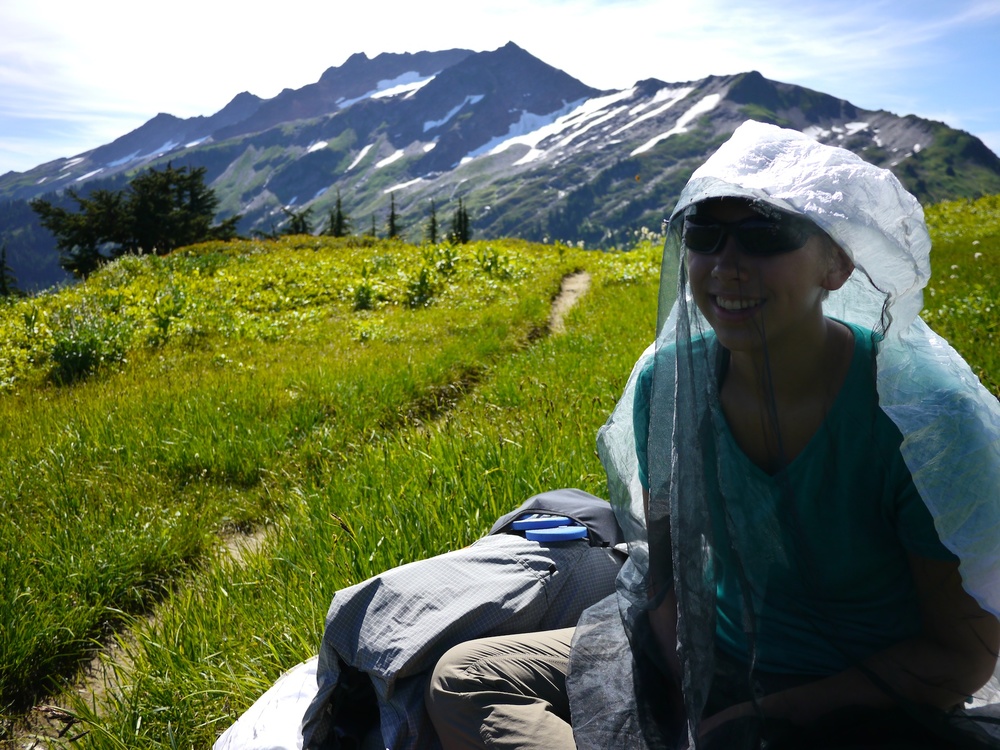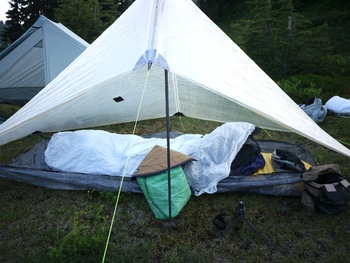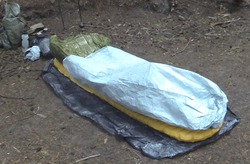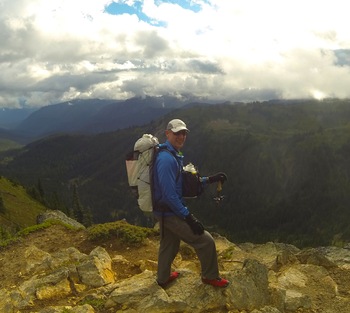The Williswall Quiver: Shelter/Sleep
The following is from an email from reader Leif:
I've been following your posts on several Forums and here at your blog. I've been especially intrigued by the B4 combination and the underlying concept of using multi-use gear as a part of an UL solution. I have not seen any updates for this last 2013 season, so I thought I'd drop you a line. If you don't mind taking a few minutes, would you respond to these questions?
1. Now that you have some testing done, do you still like the B4 solution? If not, what is taking it's place?
2. Here's my understanding of your B4 system... B4 + 3/4 Cuben bivey + Zpacks Cuben Poncho. At one point I think I saw you using a Feathered Friends Wren Nano with some kind of partial down bag for lower body insulation. Do I remember that correctly? I'm not sure if that matters... more what I'd like to know here is what are you using now for an insulating layer while sleeping? A bag?
Long story short, I'd like to know what you're using now and (if possible) how I can buy / make the same solution for myself.
Thanks in advance for your attention to this! Leif
 B4: respite from bugsLeif, thanks for writing. Let me address the topic of the B4. This has been hugely successful for my daughter and myself over the past 3 seasons and was used on just about every rest stop this past summer as the bugs were voracious. I have in fact used it a few times in the configuration you mention above with the 3/4 bivy. I have talked to Joe at ZPacks about producing this, as I have no means or interest in manufacturing, but nothing has come of it yet. He would be the most likely place to be able to produce the B4 for a reasonable price....maybe if he gets some emails asking for it?
B4: respite from bugsLeif, thanks for writing. Let me address the topic of the B4. This has been hugely successful for my daughter and myself over the past 3 seasons and was used on just about every rest stop this past summer as the bugs were voracious. I have in fact used it a few times in the configuration you mention above with the 3/4 bivy. I have talked to Joe at ZPacks about producing this, as I have no means or interest in manufacturing, but nothing has come of it yet. He would be the most likely place to be able to produce the B4 for a reasonable price....maybe if he gets some emails asking for it?
I thought the best way to respond further would be to use your questions in this blog article. Let me jump into this topic by talking about the idea of a "quiver"….just like tools of all trades, it's best to choose the appropriate tools for the job at hand. In my case I look at the type of trip I am planning for and go to the gear closet. Here are some generalities that I use in trip planning and what I would take for gear. B4, 3/4 bivy, Poncho/Groundsheet, Pocket TarpFASTPACKING SOLO: The 10 oz. system you are inquiring about fits into this category. If I am considering a trip where maximum mileage in the shortest period of time is on the docket, I want the flexibility of being able to stop and rest just about anywhere, and this may not include a site that would be amenable to setting up a tarp or a tent. For background understand that I still like to delve into the realm that is an outgrowth of ultramarathoning, and that means relentless forward movement. This is most appropriate for established trails as off trail bushwhacking can significantly slow one down, depending on the terrain. I still have a thought of beating my 36 hour Wonderland Trail hike of over 13 years ago, and this falls into this category. I would not plan on a campsite, I would simply stop when the mood struck to get an hour or a few of sleep. This may be leaning against a tree or a rock, not necessarily completely prone, but whatever is comfortable at the moment. I may not need a sleeping bag for this type of trip, but I have some options. The custom 3/4 bivy and the B4 allow me to rest just about anywhere and keep bugs and critters at bay. The addition of the Poncho allows for inclement weather. What I have is complete flexibility, allowing me to blast a trail with the minimum amount of weight yet still be safe and self sufficient if things go awry. I pack this combo on most solo trips.
B4, 3/4 bivy, Poncho/Groundsheet, Pocket TarpFASTPACKING SOLO: The 10 oz. system you are inquiring about fits into this category. If I am considering a trip where maximum mileage in the shortest period of time is on the docket, I want the flexibility of being able to stop and rest just about anywhere, and this may not include a site that would be amenable to setting up a tarp or a tent. For background understand that I still like to delve into the realm that is an outgrowth of ultramarathoning, and that means relentless forward movement. This is most appropriate for established trails as off trail bushwhacking can significantly slow one down, depending on the terrain. I still have a thought of beating my 36 hour Wonderland Trail hike of over 13 years ago, and this falls into this category. I would not plan on a campsite, I would simply stop when the mood struck to get an hour or a few of sleep. This may be leaning against a tree or a rock, not necessarily completely prone, but whatever is comfortable at the moment. I may not need a sleeping bag for this type of trip, but I have some options. The custom 3/4 bivy and the B4 allow me to rest just about anywhere and keep bugs and critters at bay. The addition of the Poncho allows for inclement weather. What I have is complete flexibility, allowing me to blast a trail with the minimum amount of weight yet still be safe and self sufficient if things go awry. I pack this combo on most solo trips.
FLEXIBLE HIKING: Another combo that has worked for light and fast in a more traditional site configuration is the ZPacks Pocket Tarp and the ZPacks Pertex Quantum Bivy; I used this a few times this past year. The Quantum bivy is not waterproof but breathes extremely well, and I have slept a few nights with just this and each of my Feathered Friends lighter bags, the 1 lb Vireo and the 1.6 lb Rock Wren. If I need protection from wind or rain, I can add the Pocket Tarp. This configuration weighs a total of 10.6 ozs, 6.6 ozs for the bivy including the bug netting and 4 ozs for the tarp including 8 titanium stakes. This past year I have used the Poncho/Groundsheet mostly as a ground sheet and usually carry it on all my trips as multi purpose gear, so one could also add this weight of just over 5 ozs. Because I'm using gear from this single manufacturer, the  Blizzard long jacket, 3/4 bivy/Poncho/GroundsheetPoncho/Groundsheet has tie outs that match clips on the Pocket Tarp to create a bathtub floor. I'll round up the weights here for a total of 16 ozs for the entire setup. What sleeping system I use depends on the season and weather, but this configuration will accommodate anything from just clothing, my momentum envelope, a 12 oz Blizzard Long Jacket, or any of my 3 bags that are rated from 45 degrees to 10 degrees. I have used the bivy(s) so far for sleeping with all the above options except the warmer 10 degree bag. Be aware that the Pocket Tarp is not advertised as a continuous use product, but more as an emergency tarp or for occasional use. Joe does this out of necessity because of the light weight of this particular cuben fabric. All I can tell you is that for benign use this past season (no torrential rain or high winds) I find it completely satisfactory, I just have to be careful not to puncture the fabric from inattention. I am confident that all the tie outs are robust enough to not be the weak point of this product. However, user beware, this light material is not meant for the inexperienced.
Blizzard long jacket, 3/4 bivy/Poncho/GroundsheetPoncho/Groundsheet has tie outs that match clips on the Pocket Tarp to create a bathtub floor. I'll round up the weights here for a total of 16 ozs for the entire setup. What sleeping system I use depends on the season and weather, but this configuration will accommodate anything from just clothing, my momentum envelope, a 12 oz Blizzard Long Jacket, or any of my 3 bags that are rated from 45 degrees to 10 degrees. I have used the bivy(s) so far for sleeping with all the above options except the warmer 10 degree bag. Be aware that the Pocket Tarp is not advertised as a continuous use product, but more as an emergency tarp or for occasional use. Joe does this out of necessity because of the light weight of this particular cuben fabric. All I can tell you is that for benign use this past season (no torrential rain or high winds) I find it completely satisfactory, I just have to be careful not to puncture the fabric from inattention. I am confident that all the tie outs are robust enough to not be the weak point of this product. However, user beware, this light material is not meant for the inexperienced.  ZPacks Hexamid Duplex 2 person tent: 19.3 ozsPARTNER HIKING: I am waiting for the arrival of the new ZPacks Hexamid Duplex. This two person tent boasts two entries and four doors that can be configured for wind direction, light to heavy rain, or open viewing. I hesitate to write about this tent before I use it, but I can at least tell you my thoughts as to why I bought it and can followup after some trips later on. I purchased this product for two reasons: room and weight. My daughter and I used a Squall Classic from Gossamer Gear (discontinued) this past summer, and it was adequate for the conditions and easy on the load at 1.5 lbs. However, only one person at a time can sit up in this tent and it's a little cramped for two with the constant worry of rubbing against the walls with your bag. This new Hexamid Duplex allows for two people to sit up at the same time with adequate room to put some distance between you and the shelter. I also like the idea of two entries for those nighttime nature calls and not having to climb over your tent mate. All this for 19.3 ozs. Add in my 8 titanium stakes and stuff sack and the total weight comes to 20.3 ozs. This is light enough for me to consider using this tent solo.
ZPacks Hexamid Duplex 2 person tent: 19.3 ozsPARTNER HIKING: I am waiting for the arrival of the new ZPacks Hexamid Duplex. This two person tent boasts two entries and four doors that can be configured for wind direction, light to heavy rain, or open viewing. I hesitate to write about this tent before I use it, but I can at least tell you my thoughts as to why I bought it and can followup after some trips later on. I purchased this product for two reasons: room and weight. My daughter and I used a Squall Classic from Gossamer Gear (discontinued) this past summer, and it was adequate for the conditions and easy on the load at 1.5 lbs. However, only one person at a time can sit up in this tent and it's a little cramped for two with the constant worry of rubbing against the walls with your bag. This new Hexamid Duplex allows for two people to sit up at the same time with adequate room to put some distance between you and the shelter. I also like the idea of two entries for those nighttime nature calls and not having to climb over your tent mate. All this for 19.3 ozs. Add in my 8 titanium stakes and stuff sack and the total weight comes to 20.3 ozs. This is light enough for me to consider using this tent solo. Wonderland Trail Sep 26, 2013CONCLUSION: I haven't gotten into the extreme gram counting that some do, trying to go SUL and XUL. This year I even indulged in a 12 oz full length Neoair Xlite pad. As a general wag my total weight, being everything on my person plus pack weight, is 12 lbs at most. This allows me to go on extended trips, including all food, for an under 20 pound load. I am just guestimating because I don't have a gram scale, but when I can shoulder a pack full of all my gear, food, clothing and water, and still not notice it's there after some hours on the trail, I know I've got it tuned right for my uses (such was the case for all my trips this past year). Much of my gear is now made of cuben fiber, including my jacket (see prior post). Although not necessary, I find having a number of options in my quiver allows me to fine tune gear for each trip. However, ultimately it's all about getting out and enjoying the outdoors, and this may be with cheap, used, or improvised gear, it matters not. What matters is the doing and the satisfaction gained. Leif, I hope this helps in your gear queries. Although I am flattered you are interested in what I use, I would encourage you to explore other's gear lists for different input, then see what works for you. Remember, I am only touting what works for me.
Wonderland Trail Sep 26, 2013CONCLUSION: I haven't gotten into the extreme gram counting that some do, trying to go SUL and XUL. This year I even indulged in a 12 oz full length Neoair Xlite pad. As a general wag my total weight, being everything on my person plus pack weight, is 12 lbs at most. This allows me to go on extended trips, including all food, for an under 20 pound load. I am just guestimating because I don't have a gram scale, but when I can shoulder a pack full of all my gear, food, clothing and water, and still not notice it's there after some hours on the trail, I know I've got it tuned right for my uses (such was the case for all my trips this past year). Much of my gear is now made of cuben fiber, including my jacket (see prior post). Although not necessary, I find having a number of options in my quiver allows me to fine tune gear for each trip. However, ultimately it's all about getting out and enjoying the outdoors, and this may be with cheap, used, or improvised gear, it matters not. What matters is the doing and the satisfaction gained. Leif, I hope this helps in your gear queries. Although I am flattered you are interested in what I use, I would encourage you to explore other's gear lists for different input, then see what works for you. Remember, I am only touting what works for me.